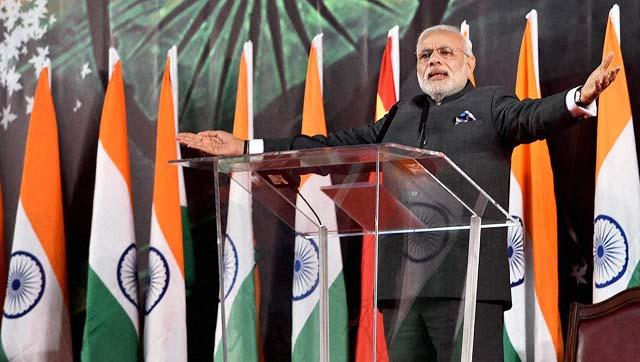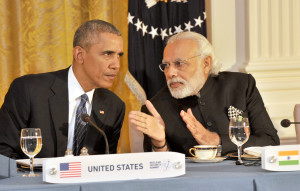‘Modi’fying Indian Foreign Policy

Indian Prime Minister Narendra Modi has reoriented foreign policy to reflect his vision of a more active, assertive and globalized nation. Since his election in 2014, Modi has played an extremely active role in shaping Indian foreign policy. Having claimed that India would “regain its rightful place in the world” under his administration, Modi’s assertive approach marks a clear shift from decades of Nehruvian non-alignment. The Prime Minister has also prioritized international relations as a source of domestic economic development. Arguably more pragmatic than some critics would claim, Modi has ushered in a new wave of Indian foreign policy by securing strong ties with rivals in a multi-polar world, maintaining a decisive but inclusive role in South Asia, and leveraging these ties to promote development in the country.
Political Relations: Implementing a Comprehensive Strategy
From the outset, the Modi government has taken the initiative to lead the South Asian Association for Regional Cooperation (SAARC) through its Neighbourhood First policy. Coming as a surprise to many, the PM invited all the heads of state from SAARC nations for his swearing-in ceremony in New Delhi in 2014. Moreover, successful interventions in Myanmar, Nepal, and Afghanistan have enhanced India’s role as a regional leader.

The Modi government has also reoriented India’s Pakistan policy during its two years. While keeping lines of bilateral engagement open, especially during its first year in power, the government has maintained a firm position against what it claims to be “state sponsored terrorism” by Pakistan. Peace negotiations with Pakistani PM Nawaz Sharif failed after attacks on Indian military bases in Pathankot and Uri. Modi has since adopted a comprehensive diplomatic strategy to isolate Pakistan, while implementing “offensive defence” in the disputed region of Kashmir.
Previous governments adopted a policy of “strategic restraint”, fearing nuclear escalation between the heavily armed neighbours. However, the current regime has proactively used diplomatic and military strategy to corner Pakistan internationally. For instance, the Indian delegation to the UN brought up Balochistan, Pakistan’s controversial separatist province, for the first time in response to allegations of abuse in Indian-controlled Kashmir. Moreover, since the Uri attack on September 18th, India, with the backing of Bhutan, Bangladesh, and Afghanistan, has decided to boycott the 2016 SAARC conference held in Islamabad. Militarily, India has claimed to have conducted anti-terror “surgical strikes” in Pakistan-controlled Kashmir, specifically targeting militant “launch pads.” While critics warn against military escalation along the precarious Line of Control (LOC) in Kashmir, some experts have welcomed India’s revamped carrots and sticks approach.

Furthermore, the Modi regime has broken away from the conventional non-alignment policy of India. In an attempt to balance power in a multipolar world, his government has deepened economic and security ties with the USA, while still acknowledging India’s longstanding military relationship with Russia. Modi has also reached out to traditional American allies, such as the UK and Japan, to balance against an increasingly expansionist China. Moreover, his visits to Shia-majority Iran and Sunni-majority Saudi Arabia, represent his government’s ability to effectively manage relations with both, without alienating either.
Economic Ties: Using International Trade to Boost Development
Modi has visited around 40 countries in his two years as PM – from Central Asia, to Europe and Africa. During his visits, he has emphasized economic investment in India, along with defence cooperation and cultural exchange. According to the United Nations Conference on Trade and Development (UNCTAD), FDI flows into India increased by almost 30% over the previous year to a seven-year high of $44 billion in 2015. Moreover, infrastructure investments, such as a $15 billion deal with Japan for the construction of a bullet rail route, will help to upgrade India’s inadequate infrastructure. According to a UNDP Report, India must create 280 million jobs by 2050 to sustain its young working force. In response, the Modi regime has opened up FDI as a mechanism to generate employment and boost growth.
While his foreign visits have been criticized as a waste of public resources by the opposition, it is still too soon to evaluate their net cost and benefit. Critics also question Modi’s trickle-down model of economic development as not being inclusive and furthering inequality. However, he has been successful in attaining a 7% GDP growth rate over the last year, and in generating FDI inflows. Furthermore, the Modi government has been unprecedented in its effort to engage the Indian diaspora around the world – which is a source of remittances and high-skilled social capital. The diaspora remits $70 billion per year, more than any other group of expats, and constituted 3.5% of the Indian GDP in 2015.
Thus, Modi’s comprehensive use of political, economic and cultural diplomacy has created a more active role for India in the realm of international relations. While his ambitions for Indian leadership on the world stage are morale boosters for his constituents, Modi must be careful not to let nationalism get in the way of long-term strategic progress.
